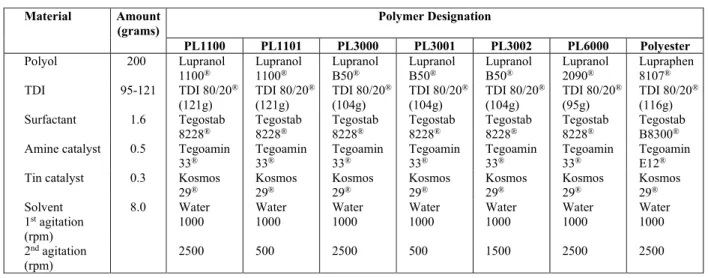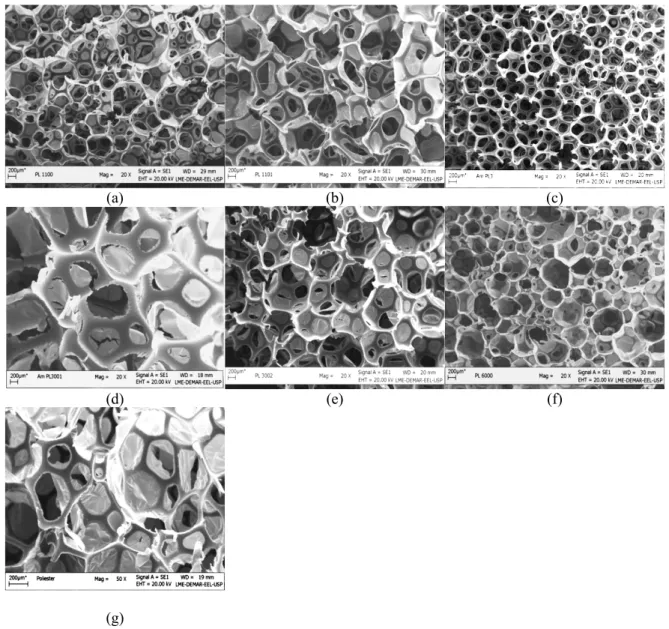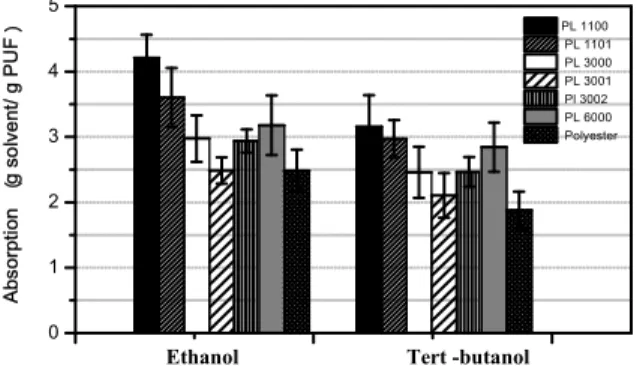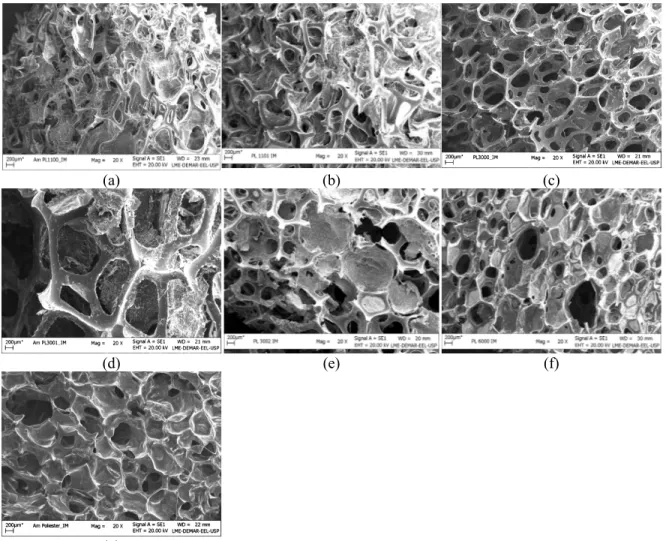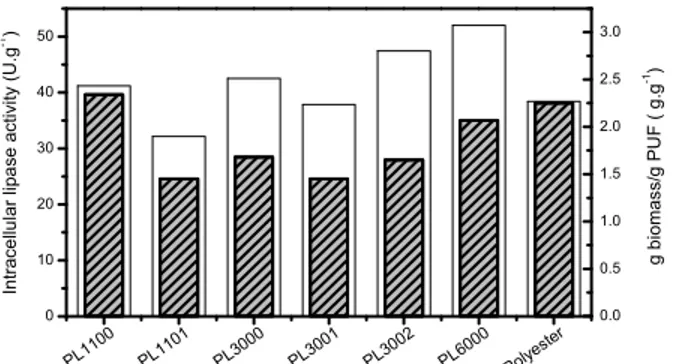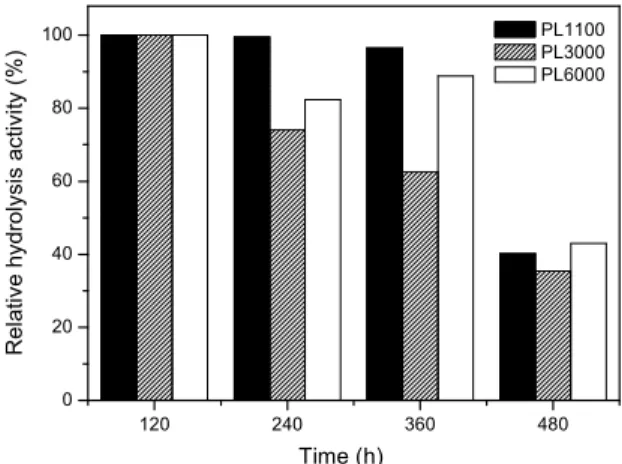ISSN 0104-6632 Printed in Brazil
www.abeq.org.br/bjche
Vol. 34, No. 01, pp. 29 - 39, January - March, 2017 dx.doi.org/10.1590/0104-6632.20170341s20140227
Brazilian Journal
of Chemical
Engineering
SYNTHESIS, CHARACTERIZATION AND
APPLICATION OF A POLYURETHANE-BASED
SUPPORT FOR IMMOBILIZING
MEMBRANE-BOUND LIPASE
M. S. Soares
1, A. L. L. Rico
1, G. S. S. Andrade
2, H. F. de Castro
1and P. C. Oliveira
1*1Engineering School of Lorena, University of São Paulo,
CEP: 12602-810 Lorena, SP, Brazil. Phone: + 55 12 31595050; Fax: + 55 12 31523224
E-mail: oliver@dequi.eel.usp.br
2Federal University of Alfenas, Institute of Science and Technology,
CEP: 37715-400, Poços de Caldas - MG, Brazil.
(Submitted: December 15, 2014 ; Revised: October 10, 2015 ; Accepted: November 17, 2015)
Abstract - This study conducted an assessment of polyurethane foams that were synthesized by one-shot
process and used as a low-cost support to immobilize Mucor circinelloides URM 4182 whole-cells presenting
high lipolytic activity. Polyols with different molecular weights (1100 to 6000 g mol-1) were applied to
synthesize the polymer matrix, and the agitation speed effect was used for controlling the average pore size of the investigated polyurethane foams. The physical and mechanical properties of the polymers were evaluated by standard test methods, and their morphology was identified by Scanning Electron Microscopy. The immobilization procedure efficiency was assessed by quantifying the capability of the matrices to attach the cells and the catalytic activity of the biocatalysts in both aqueous (olive oil hydrolysis) and non-aqueous media (ethanolysis of babassu oil) under single and consecutive batch runs. Although all synthesized matrices were suitable to immobilize the whole cells with high catalytic performance, a better set of parameters was
attained when the polyol ether with molecular weight of 6000 g mol-1 and 1100 g mol-1 was used. Both
matrices yielded immobilized biocatalysts with high hydrolysis and transesterification activities, and exhibited a satisfactory operational stability with 96% and 81% retention of their initial hydrolytic and transesterifica-tion activities after three consecutive batch runs.
Keywords: Polyurethane; Lipase; Mucor circinelloides.
INTRODUCTION
Hydrolytic enzymes such as lipase (triacylglycerol ester hydrolase, EC 3.1.1.3) have been extensively used in biocatalysis. Lipases make up a versatile group of enzymes that are able to hydrolyze triglyc-erides at a lipid-water interface, and have a number of potential applications due to their capability of catalyzing a wide range of reactions with broad sub-strate specificity (Talukder et al., 2013). However, in
major breakthrough in cost-effectiveness and sus-tainable biodiesel production, as it substantially re-duces cost by avoiding complex isolation, purifica-tion, and extracellular lipase immobilization pro-cesses (Tamalanpudi et al., 2008).
Among the established whole-cell biocatalyst sys-tems, filamentous fungi are regarded as the most robust biocatalysts for industrial applications (Romero et al., 2012). Utilizing fungal cells immobi-lized with porous BSPs (Biomass Support Particles) is an attractive technology for lowering lipase pro-duction costs, since complex purification processes are not necessary (Ban et al., 2002). Therefore, this technology is effective for bulk production com-modities, such as biodiesel (Sun et al., 2011).
Several works have been reported concerning bi-odiesel production using whole-cells derived from Rhizopus oryzae (Hama et al., 2004; Ban et al., 2008), Pseudomonas fragi (Schuepp et al., 1997), Penicillium cyclopium (Legier and Comeau, 1992), Aspergillus niger (Xiao et al., 2010; Romero et al., 2012) and Mucor circinelloides (Antczak et al., 2002; Szczesna-Antczak et al., 2004; Andrade et al., 2012).
Commercial polyurethane foams – PUFs, are the most commonly used matrices for immobilizing whole-cells in almost all these studies, due to their availability at low cost and properties such as great mechanical resistance and elasticity. This polymer also presents a high porosity level (near 97%) and a large adsorption surface that reduces oxygen dif-fusion limitations, which is a particularly relevant factor for aerobic microorganisms (De Ory et al., 2006). Nevertheless, other important properties are not suitable to immobilize all kinds of micro-organisms, particularly fungi that have different growth morphology.
Hence, the preparation of polyurethane foams is reported herein to be used as an affordable support to immobilize Mucor circinelloides URM 4182 whole-cells presenting high lipolytic activity. This filamen-tous fungus was selected based on earlier studies in which it was considered to be effective membrane-bound lipase producer that grows well in triacylglyc-erol-containing culture media with high transesterifi-cation yield (Andrade et al., 2012; Andrade et al., 2014). All PUFs were synthesized aiming at evaluat-ing the influence of rotation speed and type of polyol to be used in each formulation. The physical-mechanical properties of the matrix were used as a parameter to select the best support for immobilizing the whole-cells. The catalytic performance of the biocatalyst was assessed in both hydrolysis and transesterification reactions. Babassu oil was chosen
as feedstock in the transesterification reactions so as to enable a comparison with previous works (An-drade et al., 2012; 2014).
MATERIALS AND METHODS
Reagents
All reagents used in the PUFs synthesis were ob-tained from commercial sources. Lupranat T80A® - 80% isomer mixture 2,4- and 20% 2,6-toluene diiso-cyanate (TDI), Lupranol 1100® (MW = 1100 g mol-1, OH value = 104 mg KOH g-1), Lupranol B50® (MW = 1100 g mol-1, OH value = 104 mg KOH g-1), Lu-pranol 2090® (MW = 6000 g mol-1, OH value = 28 mg KOH g-1), Lupraphen 8107® (MW = 2400 g mol-1, OH value = 61 mg KOH g-1) and Toluene-2,4-diisocyanate (TDI) were supplied by BASF Ltd. (Guaratingueta, SP, Brazil). The catalysts tin octano-ate, tertiary amine and surfactant polysiloxane co-polymer were supplied by EVONIK (Americana, SP, Brazil). Distilled water was used as foaming agent and ethanol as cleaning solvent. Ethanol 99.8% and tert-butanol were purchased from Cromoline (Di-adema, SP, Brazil). Refined, bleached and deo-dorized babassu oil was provided by Basf Ltd. (Jaca-rei, SP-Brazil) with the following properties: acid number: 0.65 mg KOH g-1; peroxide value: 1.82 mEq kg-1; iodine number: 25 g I
2 g-1; saponification number: 238 mg KOH g-1 and the following compo-sition of fatty acids (% wt): capric (3.5), caprilic (4.5), lauric (44.7), myristic (17.5), palmitic (9.7), stearic (3.1), oleic (15.2) and linoleic (1.8) and aver-age molecular weight of TAGs: 709.9 g mol-1. Com-mercial virgin olive oil (0.3% acidity), which was purchased in a local market, was used to determine the hydrolytic activity of the biocatalysts. All other reagents were of analytical grade.
Microorganism
Synthesis, Characterization and Application of a Polyurethane-Based Support for Immobilizing Membrane-Bound Lipase 31
PUFs Preparation
PUFs were prepared by a one-shot process. At first, each polyol was mixed with the tin catalyst and stirred for 20 seconds at 1000 rpm (first agitation) to ensure a homogeneous mixture, followed by the addition of the amine catalyst, surfactant and water (ASW), under the same agitation for 15 s. TDI was then added into the premixed components and stirred for 15s (second agitation) at different speeds (500 rpm, 1500 rpm and 2500 rpm). Finally, the mixture was poured into an open rectangular mold (250 mm×200 mm×250 mm) to produce free-rise foams at 70 °C for 30 min. The obtained PUFs were left at room temperature for 24 h for a complete cure before being cut to specific dimensions for the assays to be carried out. All formulations are shown in Table 1, which were selected in agreement with the technical expertise of Evonik® aiming at preparing flexible foams with similar properties to those used in previ-ous works (Andrade et al., 2012; Andrade et al., 2014).
Immobilized Whole-Cell Biocatalyst Preparation
Polyurethane-immobilized whole-cells were pre-pared by inoculating fungal cells (1x106 spores/mL medium) in 250 mL conical flasks containing 100 mL of basal medium and 0.4 g of each cuboidal PUF (100 cubes of 6 mm) that were subjected to prior sterilization (121 °C/ 15 min) and incubated for 72 h at 28 °C on a reciprocal shaker (170 rpm), according to the methodology described by Andrade et al. (2012). The PUF-immobilized whole cell system was separated from the liquid medium by filtration, washed twice with distilled water and acetone and
dried under vacuum for 24 h to attain a water content lower than 10%.
Biodiesel Synthesis
The transesterification reactions were performed in closed Erlenmeyer flasks (250 mL) containing 60 g of substrate consisting of babassu oil and anhydrous ethanol at a molar ratio of 1:6, and tert-butanol as solvent at 1:1 proportion. The mixtures were incu-bated with immobilized whole-cells at a fixed pro-portion of 20% wt. in relation to the total weight of reactants involved in the reaction medium (Urioste et al., 2008). Reactions were carried out at 35 ºC for a maximum period of 120 h in a reciprocal shaker (170 rpm).
Batch Operational Stability Tests
The biocatalyst’s operational stability was assayed using the immobilized whole-cells (20% wt. of reac-tion medium) and substrate containing babassu oil and ethanol (molar ratio = 6) in successive batch runs (35 °C/ 120 h). At the end of each batch, the recovered immobilized whole-cells were rinsed with tert-butanol in order to remove any substrate or product that was eventually retained in the matrix. The recovered im-mobilized whole-cells were filtered under vacuum and dried to attain the required water level (lower than 10%). Then, a fresh medium was introduced in an Erlenmeyer flask containing the biocatalyst, and a new run was conducted keeping the same proportion between the reactants and the biocatalyst. Hydrolytic and transesterification activities were estimated at the end of each cycle, and expressed as mol.g-1.min-1 (Kaushiva et al., 2000; Andrade et al., 2012).
Table 1: Formulations for the synthesis of PUFs.
Material Amount (grams)
Polymer Designation
PL1100 PL1101 PL3000 PL3001 PL3002 PL6000 Polyester
Polyol 200 Lupranol 1100® Lupranol 1100® Lupranol B50® Lupranol B50® Lupranol B50® Lupranol 2090® Lupraphen 8107®
TDI 95-121 TDI 80/20®
(121g)
TDI 80/20®
(121g)
TDI 80/20®
(104g)
TDI 80/20®
(104g)
TDI 80/20®
(104g)
TDI 80/20®
(95g)
TDI 80/20®
(116g) Surfactant 1.6 Tegostab
8228® Tegostab 8228® Tegostab 8228® Tegostab 8228® Tegostab 8228® Tegostab 8228® Tegostab B8300®
Amine catalyst 0.5 Tegoamin 33® Tegoamin 33® Tegoamin 33® Tegoamin 33® Tegoamin 33® Tegoamin 33® Tegoamin E12®
Tin catalyst 0.3 Kosmos 29® Kosmos 29® Kosmos 29® Kosmos 29® Kosmos 29® Kosmos 29® Kosmos 29®
Solvent 8.0 Water Water Water Water Water Water Water 1st agitation
(rpm)
1000 1000 1000 1000 1000 1000 1000
2nd agitation
(rpm)
Downstream Procedure
At the end of each batch run, the immobilized whole-cells were recovered from the reaction medi-um, and the organic phase was washed three times with tap water to remove the free glycerol that had been formed as by-product. Residual ethanol and tert-butanol were evaporated in a rotary evaporator at 100 °C for 20 min under atmospheric pressure. The remaining water was removed by adding sodium sulfate salt.
PUFs Characterization
The PUFs morphologies were surveyed using a LEO1450VP scanning electron microscope (SEM, Schott Zeiss, Brazil). The material was cut, attached in a suitable support and then sputter-coated with gold before observation. SEM micrographs of the foams were treated using the Image J software (National Institutes of Health, NIH) to obtain the average pore diameter.
The air permeability test was assessed according to ASTM D3574-02, and it expresses the amount of closed pore in the foam. Then, the PUFs were sub-mitted to an air flow of 14 L min-1 and their flow resistance was expressed on the basis of line pressure gain, which is directly proportional to the amount of closed pores.
The apparent densities of the foams were meas-ured according to ASTM D3574-02. The dried weight divided by the calculated volume gave the density in g cm-3. Five cubic foam samples for each PUF were measured and averaged.
The water sorption and ethanol and tert-butanol absorption capacities were determined by modified ASTM F 716/726. The PUFs were cut into pieces of 30x30x10 mm, then weighed and immersed in the solvent for up to 72 hours in closed flasks. Periodi-cally, each piece was taken from the flask and weighed. Both sorption and absorption capacities were calculated according to Equation (1):
_
w 0
0
S S
Water sorption (g / g) S
(1)
where S is the initial dry weight of the sorbent 0 and S is the wet weight of the sorbent (in the wake w of water sorption). The same test was conducted with ethanol and tert-butanol. All analyses were per-formed in triplicate and the results shown are mean values with less than 5% error.
Hydrolytic Activity
The intracellular lipase activity was measured by hydrolysis using an olive oil emulsion according to the modification proposed by Andrade et al. (2012). One unit (U) of enzyme activity was defined as the amount of enzyme that released 1 mol of free fatty acid per min under the assay conditions (30 °C and pH 7).
Ethyl Esters Quantification
The ethyl esters (FAEE) formed in the transesteri-fication reaction were analyzed by FID gas chroma-tography (Varian CG 3800, Inc. Corporate Headquar-ters, Palo Alto, CA, USA) using a 5% DEGS CHR-WHP 80/100 mesh 6 ft 2.0 mm ID and 1/8” OD col-umn (Restek Frankel Commerce of Analytic Instru-ments Ltd, SP, Brazil) following previously estab-lished conditions (Urioste et al., 2008). The theoreti-cal ester concentrations were theoreti-calculated by taking into account the fatty acid composition and initial weight mass in the reaction medium, and the FAEE yield (%) was defined as the ratio between the product and the theoretical esters concentrations (Urioste et al., 2008).
Purified FAAE Characterization
The absolute viscosity of FAEE was determined with a LVDV-II cone and plate spindle Brookfield viscometer (Brookfield Viscometers Ltd., U.K.) us-ing a CP 42 cone. A circulatus-ing water bath was used to maintain the temperature at 40 °C during the as-says. The shear stress measurements were taken as a function of shear rate, and the dynamic viscosity was determined as a slope constant. Ethyl esters samples of 0.5 mL were used and measurements were repli-cated three times (Urioste et al., 2008). The density of FAEE was found with a DMA 35N EX digital densimeter (Anton Paar). The temperature was main-tained at 20 °C during the assays. Ethyl esters sam-ples of 2.0 mL were used and measurements were replicated three times.
RESULTS AND DISCUSSION
PUFs Synthesis and Characterization
agita-Synthesis, Characterization and Application of a Polyurethane-Based Support for Immobilizing Membrane-Bound Lipase 33
tion speed at 2500 rpm had an average pore size (0.30 0.12 mm) that was smaller than that of the same formulation, renamed PL1101, with 0.57 0.16 mm of average pore size at an agitation speed of 500 rpm. The same behavior was observed in the PL3000 series. Figure 1c-e shows that, for PL 3000 at 2500 rpm, an average pore size of 0.24 0.14 mm was achieved. PL 3001 was prepared with an agita-tion speed of 500 rpm and the average pore size was 0.85 0.14 mm, while PL3002 was prepared at 1500 rpm and the average pore size was 0.52 0.14 mm. PL 6000 and Polyester, both prepared with an agita-tion speed of 2500 rpm, had an average pore size of
0.25 0.10 mm and 0.32 0.09 mm, respectively. These results indicate that, keeping the same for-mulation, the PUF pore size can be influenced only by changing the second agitation speed. A higher agi-tation speed increased the nucleation of air mi-crobubbles inside the polymer for a particular formu-lation. It should also be considered that as the vol-ume of carbon dioxide (CO2) formed is the same at all agitation speeds, the amount of CO2 in each mi-crobubble will be lower in the foam with a greater number of nucleated microbubbles, resulting in the formation of small cells with a greater amount of pores per area (Kaushiva et al., 2000).
(a) (b) (c)
(d) (e) (f)
(g)
Table 2: PUF characterization. PUF designation Second agitation (rpm) Pore size (mm) Apparent density (kg m-³)
Air permeability – pressure drop
(mm H2O)
PL1100 2500 0.30 0.12 22.0 13 – 14 PL1101 500 0.57 0.16 24.0 25 – 26 PL3000 2500 0.24 0.14 33.0 6 – 7 PL3001 500 0.85 0.21 25.0 3 – 4 PL3002 1500 0.52 0.14 27.0 4 – 5 PL6000 2500 0.25 0.10 23.0 20 – 21 Polyester 2500 0.32 0.14 23.0 100 – 110
The physical and mechanical properties of the polymers were evaluated by standard test methods (Table 2). The apparent density did not show a linear relationship with, either the agitation speed or with the pore size, attaining values in the range of 22–25 kg m-3 (Table 2). The porosity of the PUFs was measured by an air permeability test, since there is a relation between the air flow resistance (pressure drop) and the amount of closed pores. The PUF, named “Polyester”, showed the highest pressure drop, 100-110 mm H2O, indicating a significant number of closed pores. The PL3000 series synthesized with Lupranol B50® had the greater number of open pores and the lowest pressure drop (Table 2).
The results were also analyzed statistically by ANOVA for the major effects (PUF type and second agitation). These factors revealed only a significant effect (p < 0.05) on the pore size. The results also demonstrate that the second agitation substantially affected the pore size of PUF.
The water diffusion within the polymeric matrixes, as shown in Figure 2, could be related to the polyol type, air permeability and pore size. Among the PUFs, Polyester showed the lowest water sorption capacity (14.4 g g-1) after 72 h, probably due to the large amount of closed pores and hydrophobic character. However, both PL1100 and PL3000 showed the highest values of water sorption after the same period, 27.7 g g-1. As the water sorption is related to polarity, an increase in the amount of ethylene oxide pushes the hydrophilic character of the matrix up, and the larger the amount of propylene oxide, the more evi-dent the hydrophobic character of the matrix is going to be (Thomson, 2005). As can also be seen in Figure 2, after 48 hours of immersion, all PUFs had reached equilibrium at maximum water retention and no fur-ther sorption was observed.
Polymer matrices with large surface area, uniform porosity and good stability are usually permeable to fluids, mainly organic solvents. The solvent sorption capacities of PUFs indicated that all foams were
in-stantly swollen with tert-butanol and ethanol (Figure 3), and they exhibited resistance to water diffusion. Gopakuma and Nair (2005) used polyurethane and a natural rubber block copolymer for studying the solvent diffusion at different polyol to isocyanate molar ratios. According to these authors, solvents having solubility parameter values higher or lower than those of the foam interact with only one poly-meric segment of the copolymer. The authors also concluded that decreasing the polyol to isocyanate molar ratio helps increase the swelling degree of the matrices due to decreasing alofanate bonds, which are those responsible for cross-linking the polymer. A high solubility value promotes the best interaction between the flexible (polyol chains) and rigid seg-ments of the matrix, allowing better solvent diffusion within the polymeric matrix. Considering that all foams have no diffusion problems to adsorb ethanol and tert-butanol (reagents used in the biodiesel synthesis), a decision was made to carry out immobi-lization assays using all synthesized supports, alt-hough the PL1100 and PL1101 matrices showed bet-ter efficiency in adsorbing both solvents (Figure 3).
0 1 2 3 24 48 72
0 5 10 15 20 25 30 W a ter sorpt io n (g/g ) time (h)
Figure 2: Water sorption capacity of PUFs made with different formulations as displayed in Table 1. Symbols: () PL1100, () PL1101, () PL3000, () PL3001, () PL3002, () PL6000, (►) Polyester.
0 1 2 3 4 5
Ethanol Tert -butanol
A b s o r p t i o n g s o l v e n t / g P U
F P L 1 1 0 0 P L 1 1 0 1
P L 3 0 0 0 P L 3 0 0 1 P l 3 0 0 2 P L 6 0 0 0 P o l y e s t e r
Synthesis, Characterization and Application of a Polyurethane-Based Support for Immobilizing Membrane-Bound Lipase 35
Immobilization of Whole Cells from M.
circinel-loides on Different PUFs
M. circinelloides cells were immobilized in situ on all synthesized foams according to the methodol-ogy previously described by Andrade et al. (2012). The immobilization with PUF was a natural conse-quence of cell growth during cultivation and is the most common procedure to obtain immobilized whole-cells. As can be seen in Figure 4 a-g (SEM images), strong cellular adhesions were verified on all matrices, which mean that the cells would not be easily released from the PUF particles, even under vigorous agitation. M. circinelloides whole-cells are fully entangled filaments that facilitate the formation of a strong biofilm inside and around PUF particles.
Intracellular lipase activities and immobilization ratios (proportional to the fixed biomass per gram of foam) are shown in Figure 5. Although all formula-tions were found to be suitable to immobilize M. circinelloides cells, the PUF formulation affected
both the attachment of cells to the support and the lipolytic activities, attaining values ranging from 1.4 to 2.4 g biomass/gPUF and lipase activities from 32 to 52 U g-1,respectively.
Immobilized whole-cells on PL1100 showed the highest immobilization ratio, which is probably due to the hydrophobic character of the polyol used in this formulation, thus increasing the interaction be-tween the cells and the matrix, as can be seen in the SEM image (Figure 4a). This can provide the immo-bilized biomass with additional protection against shear forces. On the other hand, the immobilization ratio could also be related to the PUF pore size, since PL3001 and PL1101 which have the highest values of average pore size showed the lowest amount of immobilized biomass.
Among the polymers, PL6000 gave the maximum intracellular lipase production (52 U g-1), which was slightly superior to that of previously reported results (49 U g-1) using the same fungal strain and com-mercial foam particles as support (Scotch-BriteMR)
(a) (b) (c)
(d) (e) (f)
(g)
(Andrade et al., 2012). A remarkable cell growth (high immobilization ratios) was also achieved for PL1100 and PL 3002 matrices, although slightly lower hydrolytic activities were found (respectively 42 and 47 U g-1). Such differences can be attributed to the different properties of each PUF. The matrices PL1101, PL3001 and Polyester, which have low water sorption capacity, produced immobilized cata-lysts with low hydrolytic activities (< 40 U g-1), probably due to the mass transfer limitations of the substrate to the mycelia within the matrix pores.
PL11 00 PL11 01 PL30 00 PL30 01 PL30 02 PL60 00 Polye ster 0 10 20 30 40 50 Intrace llu la r l ip a s e acti v ity (U.g -1) 0.0 0.5 1.0 1.5 2.0 2.5 3.0 g bio m a ss/ g P U F ( g. g -1)
Figure 5: Intracellular lipase activity (open bar) and ratio biomass/PUF (closed bar) obtained from M. circinelloides immobilized on PUFs cultivated with olive oil (3%) at 30 °C and 170 rpm for 72 h.
Catalytic Performance of the Immobilized Whole-Cells
The biocatalysts catalytic performance was as-sessed in the transesterification reaction of babassu oil with ethanol, and the results are shown in Figure 6 and Table 3.
0 24 48 72 96 120
0 10 20 30 40 50 60 70 80 90 FAEE y iel d (%) time (h)
Figure 6: FAEE yields attained as function of time in the ethanolysis of babassu oil using M. circinel-loides whole cells immobilized on () PL1100, () PL1101, () PL3000, () PL3001, () PL3002, () PL6000, (►) Polyester.
Table 3: Properties of the purified product ob-tained in the transesterification reaction of babas-su oil and ethanol catalyzed by M. circinelloides immobilized on different PFUs
Biocatalyst immobilized in PUF Property FAEE (%) Viscosity (mm2 s-1)
Density (kg m-3)
PL1100 83.1 6.3 5.8 1.9 883 PL1101 79.5 1.4 6.1 0.4 887 PL3000 84.1 2.7 5.6 0.2 886 PL3001 77.3 0.3 6.6 0.9 888
PL3002 80.1 4.4 6.1 0.1 886 PL6000 87.3 1.1 5.3 0.4 884 Polyester 64.4 2.3 10.4 0.4 891
The reaction progress in terms of FAEE yield is displayed in Figure 6. These values indicate that both the reaction rate and ester yield are dependent on the immobilized cells activity, which is directly related to the matrix used. The highest FAEE yield (87.3%) was achieved using cells immobilized on PL6000. Slightly lower FAEE yields (83.1 and 84.1%) were achieved in the transesterification reactions mediated by cells immobilized on PL1100 and PL3000. Simi-lar results were produced in earlier studies (Andrade et al., 2012), when whole-cells of M. circinelloides were immobilized on commercial PUF, and reached 83.2% yield in the ethanolysis of babassu oil.
Low performances were attained with the other biocatalyst, and the lowest yield (64.4%) was achieved for the cells immobilized on Polyester. This result can be explained by the physical properties of the matrix (Polyester), which has a large number of closed pores that influenced the insertion and adhe-sion of mycelia inside the pores. In addition, this matrix exhibited the lowest water sorption capacity, as shown in Figure 2, which indicates a hydrophobic character.
Synthesis, Characterization and Application of a Polyurethane-Based Support for Immobilizing Membrane-Bound Lipase 37
its properties such as a very large surface area and suitable porosity to promote the cells growth.
Whole-Cells Operational Stability
The operational stability of the cells immobilized on PL1100, PL3000 and PL6000, which achieved the highest FAEE yields, were assayed under repeated batch runs. At the end of each batch run (120 h), the immobilized biocatalyst was removed from the reac-tion medium and treated by the previously described methodology. Hydrolytic and transesterification ac-tivities were estimated at the end of each batch and the first batch was taken as 100% active.
Figures 7 and 8 show the relative activities (hy-drolysis and transesterification) as function of opera-tional time. After three consecutive batches, a de-crease in both activities for the three immobilized whole-cells was observed as a consequence of the cell weight loss during the repeated batches. For all assays, the initial weight of the immobilized cells markedly decreased (average value was estimated to be at least 30%) after three repeat cycles. Therefore, the hydrolytic activity decrease can be related to the cell exfoliation caused by agitation, resulting in a significant loss of cells during the biocatalyst re-covery by filtration.
Regarding the transesterification activity, the strategy of balancing the biocatalyst loading as a means of decreasing the substrate volume pro-portionally enabled an assessment of the actual activity loss due to biocatalyst inhibition by the glycerol formed as byproduct in the transesterifica-tion reactransesterifica-tion.
120 240 360 480
0 20 40 60 80 100
R
e
la
ti
ve
h
y
d
ro
lysis a
c
ti
vi
ty
(%)
Time (h)
PL1100 PL3000 PL6000
Figure 7: Relative activity of immobilized biocata-lyst during consecutive batch hydrolysis runs, taking as 100% active the original activity of the whole cells immobilized on PL 1101 (42 U g-1); PL 3000 (42 U g-1) and PL 6000 (52 U g-1).
120 240 360
0 20 40 60 80 100
Re
la
ti
v
e
tr
an
s
e
s
ter
if
ic
ati
on
ac
ti
v
ity
(
%
)
Time (h)
PL1100 PL3000 PL6000
Figure 8: Relative activity of immobilized biocatalyst during consecutive batch transesterification runs, taking as 100% active the original activity of the whole cells immobilized on PL 1101 (210 µM.g-1.min-1); PL 3000 (225 µM g-1 min-1); PL 6000 (240 µM g-1 min-1).
An alternative approach to avoid the biocatalyst weight loss is to perform the assay in a basket batch reactor (Baltaru et al., 2009) or under a continuous run (Yoshida et al., 2012).
CONCLUSIONS
Polyurethane foams were synthesized, charac-terized, and used as support for the immobilization of Mucor circinelloides whole-cells and assessed as biocatalyst in the transesterification reaction of ba-bassu oil with ethanol. PL1100 and PL1101 showed optimum interactions with ethanol and tert-butanol. PL6000 was the best foam in the ethanolysis and PL1100 was that with the highest operational stability. A smaller microbubble diameter resulted in good dispersion, permeability, and water sorption of the biofilm to the porous matrix. These were the most important properties for suitable nutrient diffusion, allowing whole-cell growth and intracellular lipase production. The immobilization was influenced by the pore diameter of the polymer matrix, water sorption and solvent absorption, as well as the type of polyol used in the synthesis. Furthermore, the hydrophobic and hydrophilic character of the matrix influenced the attachment of the microorganism, providing better compatibility with the reaction medium, aiding the nutrient and substrate transfers.
ACKNOWLEDGMENTS
de Desenvolvimento Científico e Tecnológico), Brazil. They would also like to acknowledge and demon-strate their appreciation for the remarkable language revision provided by FAV Language Services.
REFERENCES
Adachi, D., Koh, F., Hama, S., Ogino, C., Kondo, A., A robust whole-cell biocatalyst that introduces a thermo- and solvent-tolerant lipase into Aspergil-lus oryzae cells: Characterization and application to enzymatic biodiesel production. Enzyme and Microbiology Technology, 52, 331-335 (2013). Andrade, G. S. S., Freitas, L., Oliveira, P. C., de
Cas-tro, H. F., Screening, immobilization and utiliza-tion of whole cell biocatalysts to mediate the ethanolysis of babassu oil. Journal of Molecular Catalysis, B: Enzymatic, 84, 183-188 (2012). Andrade, G. S. S., Carvalho, A. K. F., Romero, C.
M., Oliveira, P. C., de Castro, H. F., Mucor cir-cinelloides whole-cells as a biocatalyst for the production of ethyl esters based on babassu oil. Bioprocess and Biosystems Engineering, 37, 2539-2548 (2014).
Antczak, T., Hiler, D., Krystynowicz, A., Szczesna-Antczak, M., Bielecki, S., Galas, E., Activity of immobilised in situ intracellular lipases from Mu-cor circinelloides and Mucor racemosus in the synthesis of sucrose esters. Progress in Biotech-nology, 17, 221-227 (2002).
Athalye, S., Sharma-Shivappa, R., Peretti, S., Kolar, P., Davis, J. P., Producing biodiesel from cotton-seed oil using Rhizopus oryzae ATCC #34612 whole cell biocatalysts: Culture media and culti-vation period optimization. Energy for Sustaina-ble Development, 17, 331-336 (2013).
Baltaru, R., Galaction, A. I., Cascaval, D., Bioreac-tors of basket type with immobilized biocatalysts. In: 2nd Wseas International Conference on Bio-medical Electronics and BioBio-medical Informatics, Russia (2009).
Ban, K., Kaieda, M., Matsumoto, T., Kondo, A., Fukuda, H., Whole cell biocatalyst for biodiesel fuel production utilizing Rhizopus oryzae cells immobilized within biomass support particles. Biochemical Engineering Journal, 8, 39-43 (2001).
Ban, K., Hama, S., Nishizuka, K., Kaieda, M., Matsumoto, T., Kondo, A., Noda, H., Fukuda, H., Repeated use of whole-cell biocatalysts immobi-lized within biomass support particles for
bio-diesel fuel production. Journal of Molecular Ca-talysis, B: Enzymatic, 17, 157-165 (2002). Chen, J-P.,Lin, G-H., Optimization of biodiesel
pro-duction catalyzed by fungus cells immobilized in fibrous supports. Applied Biochemical and Bio-technology, 161, 181-194 (2010).
De Ory, I., Cabrera, G. M., Blandino, A., Immobili-zation of Cells on Polyurethane Foam. In: Guisan, J. M. (Ed.) Methods in Biotechnology: Immobili-zation of Enzymes and Cells. 2nd Ed., Totowa, Humana Press Inc., p. 357-365 (2006).
Gopakumar, S., Nair, M. R. G., Determination of molecular parameters of NR/PU block copoly-mers by transport studies. European Polymer Journal, 41, 2002-2009 (2005).
Hama, S., Yama, H., Kaieda, M., Oda, M., Kondo, A., Fukuda, H., Effect of fatty acid membrane composition on whole-cell biocatalysts for bio-diesel-fuel production. Biochemical Engineering Journal, 21, 155-160 (2004).
Kaushiva, B. D., McCartney, S. R., Rossmy, G. R., Wilkes, G. L., Surfactant level influences on structure and properties of flexible slabstock polyurethane foams. Polymer, 41, 285-310 (2000).
Legier, V., Comeau, L. C., Continuous synthesis of esters by cell-bound fungal lipases in an organic solvent. Applied Microbiology and Biotechnolo-gy, 37, 732-736 (1992).
Romero, C. M., Pera, L. M., Olivaro, C., Vazquez, A., Baigori, M. D., Tailoring chain length selec-tivity of a solvent-tolerant lipase acselec-tivity from Aspergillus niger MYA 135 by submerged fer-mentation. Fuel Processing Technology, 98, 23-29 (2012).
Schuepp, C., Kermasha, S., Michalski, M. C., Morin, A., Production, partial purification and character-ization of lipases from Pseudomonas fragi CRDA 037. Process Biochemistry, 32, p. 225-232, 1997. Sun, T., Du, W., Liu, D., Comparative study on sta-bility of whole cell during biodiesel production in solvent free system. Process Biochemistry, 48, 661-664 (2011).
Szczesna-Antczak, M., Antczak, T., Rzyska, M., Modrzejewska, Z., Patura, J., Kalinowska, H., Bielecki, S., Stabilization of an intracellular Mu-cor circinelloides lipase for application in non-aqueous media. Journal of Molecular Catalysis, B: Enzymatic, 29, 163-171 (2004).
Aspergil-Synthesis, Characterization and Application of a Polyurethane-Based Support for Immobilizing Membrane-Bound Lipase 39
lus nomius for methanolysis of palm oil to bio-diesel. Journal of Molecular Catalysis, B: Enzy-matic, 89, 108-113 (2013).
Tamalanpudi, S., Talukder, M. R., Hama, S., Numata, T., Kondo, A., Fukuda, H., Enzymatic production of biodiesel from Jatropha oil: A comparative study of immobilized-whole cell and commercial lipases as a biocatalysts. Biochemical Engineer-ing Journal, 39, 185-189 (2008).
Thomson, T., Polyurethanes as Specialty Chemicals – Principles and Applications. 1st Ed., CRC Press (2005).
Urioste, D., Castro, M. B. A., Biaggio, F. C., de Cas-tro, H. F., Synthesis of chromatographic standards
and establishment of a method for the quantifica-tion of the fatty ester composiquantifica-tion of biodiesel from babassu oil. Química Nova, 31, 407-412 (2008).
Xiao, M., Mathew, S., Obbard, J. P., A newly isolated fungal strain used as whole-cell biocatalyst for biodiesel production from palm oil. Global Change Biology Bioenergy, 2, 45-51 (2010). Yoshida, A., Hama, S., Tamadani, N., Fukuda, H.,
